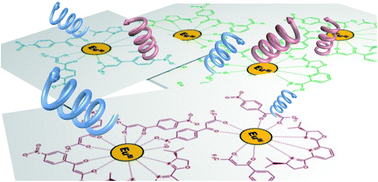Evaluation of circularly polarized luminescence in a chiral lanthanide ensemble†
Abstract
This work demonstrates a methodology for the evaluation of circularly polarized luminescence of a chiral europium(III) (EuIII) complex species in an ensemble system. The chiral EuIII complex species consists of chiral bis(oxazolinyl)pyridine [(R)- or (S)-iPr-Pybox] and β-diketonate ligands with a pendant nitro group (DK-NO2). The pendant NO2 group in [iPr-Pybox](EuIII)(DK-NO2)3 (monometallic EuIII species) coordinates to the EuIII center of another EuIII complex, giving rise to the generation of a chiral EuIII ensemble consisting of mono-, di-, and the other oligomeric EuIII species, {[iPr-Pybox](EuIII)(DK-NO2)3}n. The luminescence dissymmetry factors (glum) of the chiral EuIII ensemble have been successfully determined by using a commercially available fluorescence spectrophotometer attached with a rotatable λ/4 filter and a fixed linearly polarized plate. This study suggests that the chiral EuIII ensemble in solution displays a large circularly polarized luminescence (|glum| = 0.19) as compared to that of a reference monometallic complex [iPr-Pybox](EuIII)(DK-CN)3 (|glum| = 0.11–13). The larger glum is primarily attributed to the contribution of the dimetallic EuIII species exhibiting a high degree of circular polarization in luminescence (glum2 = 0.27) in the ensemble. Conversely, a large linearly polarized component was observed in luminescence from the chiral EuIII ensemble in the solid state (KBr pellet).

- This article is part of the themed collection: MSDE Emerging Investigators 2018


 Please wait while we load your content...
Please wait while we load your content...